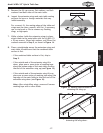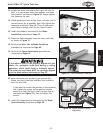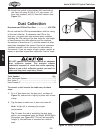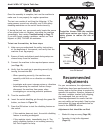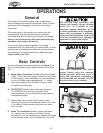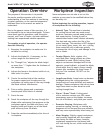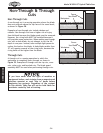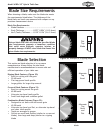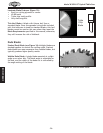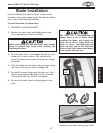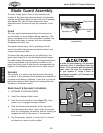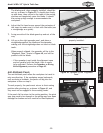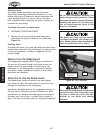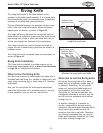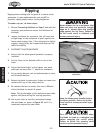
Df[\cN(/)+('?pYi`[KXYc\JXn
-25-
FG<I8K@FEJ
Blade Size Requirements
When choosing a blade, make sure the blade size meets
the requirements listed below. The thickness of the
blade body and teeth can measured with calipers or any
precision measurement device.
Blade Size Requirements:
• Blade Diameter ......................................... 10"
• Body Thickness ..............0.071"–0.094" (1.8–2.4mm)
• Kerf (Tooth) Thickness .....0.102"–0.126" (2.6–3.2mm)
Using a blade that does not meet the specified blade
size requirements presents a hazardous condition
that could cause kickback, operator injuries, or
properly damage. ALWAYS use a blade that meets the
given blade size requirements.
Blade Selection
This section on blade selection is by no means
comprehensive. Always follow the saw blade
manufacturer's recommendations to ensure safe and
efficient operation of your table saw.
Ripping Blade Features (Figure 30):
• Best for cutting with the grain
• 20-40 teeth
• Flat-top ground tooth profile
• Large gullets for large chip removal
Crosscut Blade Features (Figure 31):
• Best for cutting across the grain
• 60-80 teeth
• Alternate top bevel tooth profile
• Small hook angle and a shallow gullet
Combination Blade Features (Figure 32):
• Designed to cut both with and across grain
• 40-50 teeth
• Alternate top bevel and flat, or alternate top bevel
and raker tooth profile
• Teeth are arranged in groups
• Gullets are small and shallow (similar to a cross-cut
blade), then large and deep (similar to a ripping
blade
Figure 30. Example of a ripping blade.
=cXk
Kfg
9cX[\
Figure 31. Example of a crosscut blade.
8ck\ieXk\
Kfg
9\m\c
Figure 32. Example of a combination
blade.
8ck\ieXk\
Kfg
9\m\c
Xe[
=cXk



